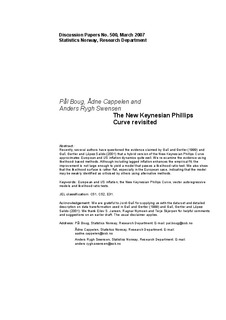| dc.contributor.author | Boug, Pål | |
| dc.contributor.author | Cappelen, Ådne | |
| dc.contributor.author | Swensen, Anders Rygh | |
| dc.date.accessioned | 2011-11-05T21:04:03Z | |
| dc.date.available | 2011-11-05T21:04:03Z | |
| dc.date.issued | 2007 | |
| dc.identifier.issn | 1892-753x | |
| dc.identifier.uri | http://hdl.handle.net/11250/180855 | |
| dc.description.abstract | Abstract:
Recently, several authors have questioned the evidence claimed by Galí and Gertler (1999) and Galí, Gertler and López-Salido (2001) that a hybrid version of the New Keynesian Phillips Curve approximates European and US inflation dynamics quite well. We re-examine the evidence using likelihood-based methods. Although including lagged inflation enhances the empirical fit, the improvement is not large enough to yield a model that passes a likelihood ratio test. We also show that the likelihood surface is rather flat, especially in the European case, indicating that the model may be weakly identified as criticised by others using alternative methods.
Keywords: European and US inflation, the New Keynesian Phillips Curve, vector autoregressive models and likelihood ratio tests. | no_NO |
| dc.language.iso | eng | no_NO |
| dc.publisher | Statistics Norway, Research Department | no_NO |
| dc.relation.ispartofseries | Discussion Papers;No. 500 | |
| dc.subject | New Keynesian Phillips Curve | no_NO |
| dc.subject | Vector autoregressive models | no_NO |
| dc.subject | Inflation | no_NO |
| dc.subject | JEL classification: C51 | no_NO |
| dc.subject | JEL classification: C52 | no_NO |
| dc.subject | JEL classification: E31 | no_NO |
| dc.title | The New Keynesian Phillips Curve revisited | no_NO |
| dc.type | Working paper | no_NO |
| dc.subject.nsi | VDP::Social science: 200::Economics: 210::Economics: 212 | no_NO |
| dc.source.pagenumber | 22 s. | no_NO |
